

Compact Muon Solenoid
LHC, CERN
| CMS-SUS-18-005 ; CERN-EP-2019-114 | ||
| Combined search for supersymmetry with photons in proton-proton collisions at $\sqrt{s} = $ 13 TeV | ||
| CMS Collaboration | ||
| 1 July 2019 | ||
| Phys. Lett. B 801 (2020) 135183 | ||
| Abstract: A combination of four searches for new physics involving signatures with at least one photon and large missing transverse momentum, motivated by generalized models of gauge-mediated supersymmetry (SUSY) breaking, is presented. All searches make use of proton-proton collision data at $\sqrt{s} = $ 13 TeV, which were recorded with the CMS detector at the LHC in 2016, and correspond to an integrated luminosity of 35.9 fb$^{-1}$ . Signatures with at least one photon and large missing transverse momentum are categorized into events with two isolated photons, events with a lepton and a photon, events with additional jets, and events with at least one high-energy photon. No excess of events is observed beyond expectations from standard model processes, and limits are set in the context of gauge-mediated SUSY. Compared to the individual searches, the combination extends the sensitivity to gauge-mediated SUSY in both electroweak and strong production scenarios by up to 100 GeV in neutralino and chargino masses, and yields the first CMS result combining various SUSY searches in events with photons at $\sqrt{s} = $ 13 TeV. | ||
| Links: e-print arXiv:1907.00857 [hep-ex] (PDF) ; CDS record ; inSPIRE record ; HepData record ; CADI line (restricted) ; | ||
| Figures & Tables | Summary | Additional Figures | References | CMS Publications |
|---|
| Figures | |
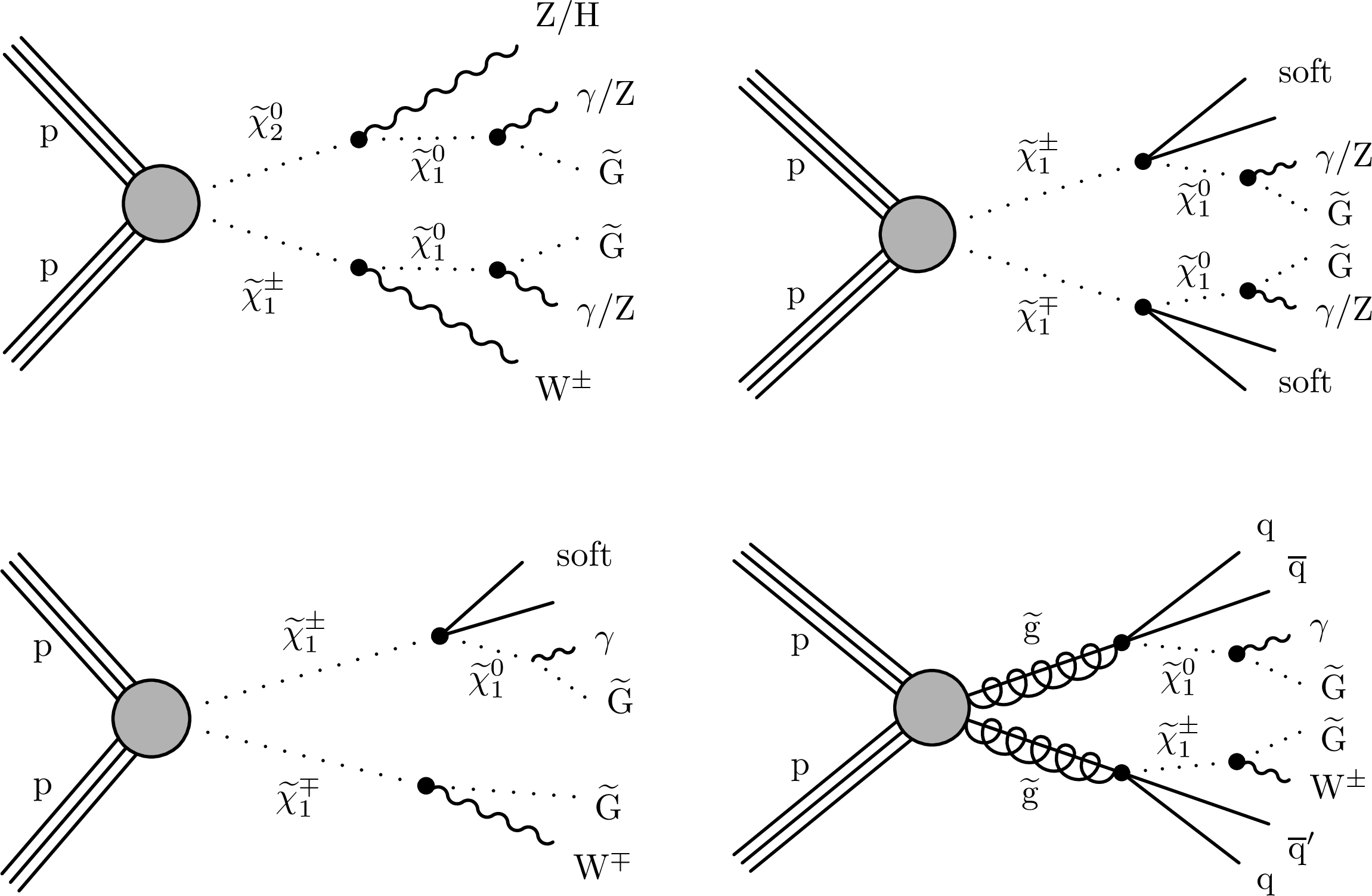
png pdf |
Figure 1:
Diagrams of the SUSY processes considered in this Letter: one process within the GGM scenario (upper left), two EW SMS processes, with possible neutralino and chargino decays (upper right and lower left), and a strong SMS process based on gluino pair production (lower right). |

png pdf |
Figure 1-a:
Diagram of SUSY process within the GGM scenario. |

png pdf |
Figure 1-b:
Diagram of a EW SMS process, with possible chargino and neutralino decays. |
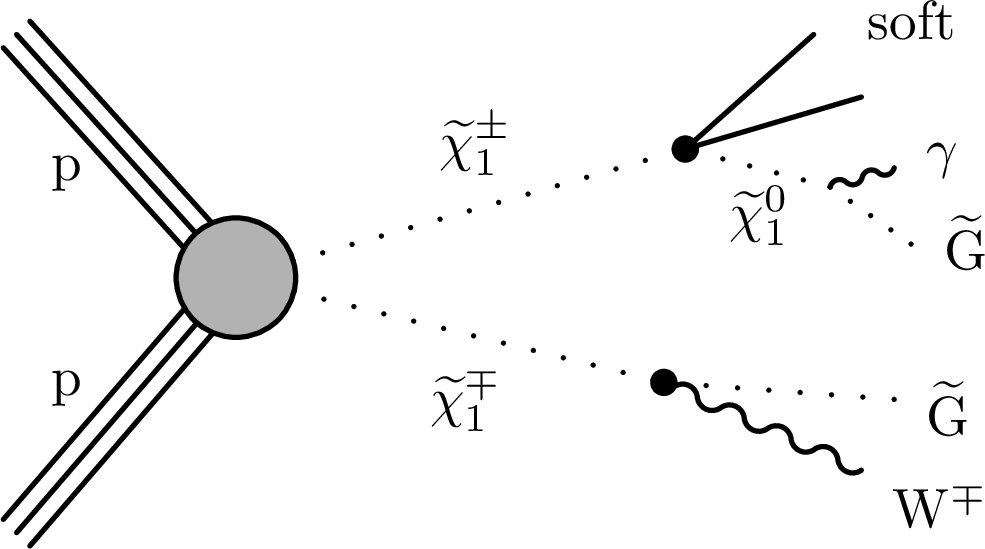
png pdf |
Figure 1-c:
Diagram of a EW SMS process, with possible chargino and neutralino decays. |
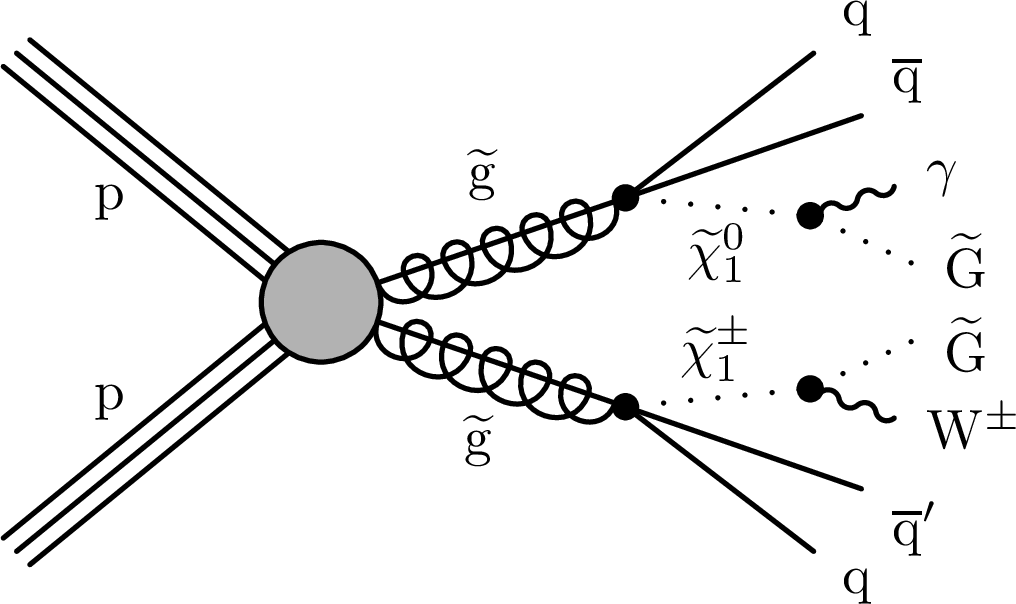
png pdf |
Figure 1-d:
Diagram of a strong SMS process based on gluino pair production. |
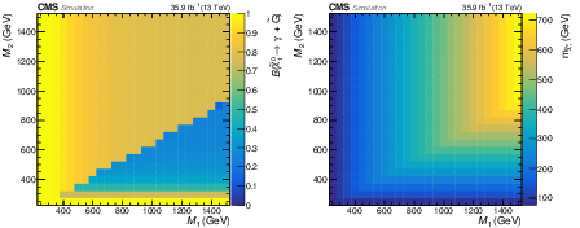
png pdf |
Figure 2:
Branching fractions ($B$) for the NLSP decay to a photon and a gravitino for the GGM scenario (left). The phase space is spanned by the bino ($ {{M_\mathrm {1}}} $) and wino ($ {{M_\mathrm {2}}} $) mass parameters showing the change of the NLSP composition. This change also influences the dependence of the physical mass of the neutralino ($m_{\tilde{\chi}^0_1}$) on the gauge mass parameters (right). |

png pdf |
Figure 2-a:
Branching fractions ($B$) for the NLSP decay to a photon and a gravitino for the GGM scenario. The phase space is spanned by the bino ($ {{M_\mathrm {1}}} $) and wino ($ {{M_\mathrm {2}}} $) mass parameters showing the change of the NLSP composition. This change also influences the dependence of the physical mass of the neutralino ($m_{\tilde{\chi}^0_1}$) on the gauge mass parameters (right). |
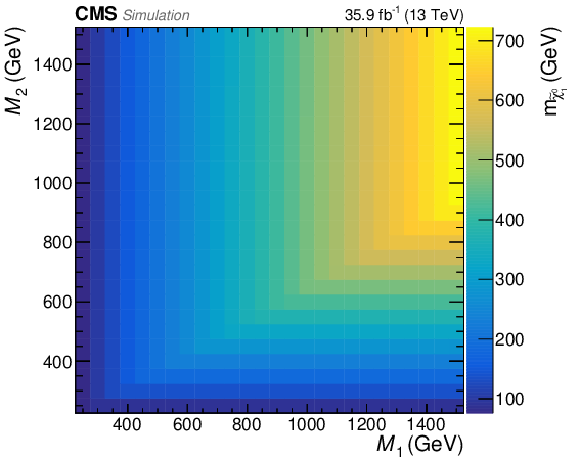
png pdf |
Figure 2-b:
Physical mass of the neutralino ($m_{\tilde{\chi}^0_1}$). The phase space is spanned by the bino ($ {{M_\mathrm {1}}} $) and wino ($ {{M_\mathrm {2}}} $) mass parameters. |
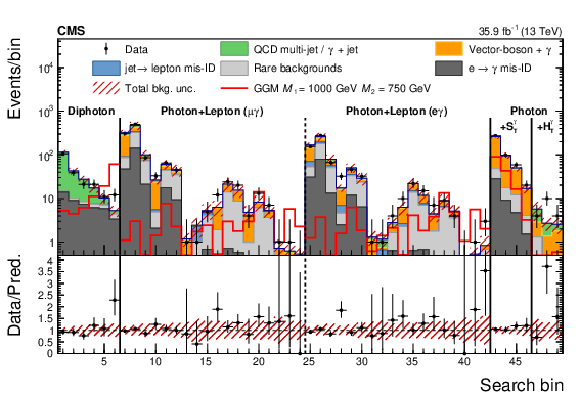
png pdf |
Figure 3:
Predicted pre-fit background yields, where the values are not constrained by the likelihood fit, and observed number of events in data for all search bins used in the combination. The search bins are defined in Table 2. The hatched red bands in both parts of the plot represent the total uncertainty of the background prediction. The red line in the upper panel shows the signal prediction for one specific signal point of the GGM scenario with $M_{1} = $ 1000 GeV and $M_{2} = $ 750 GeV. The lower panel shows the ratio between the observed data and the predicted backgrounds. |
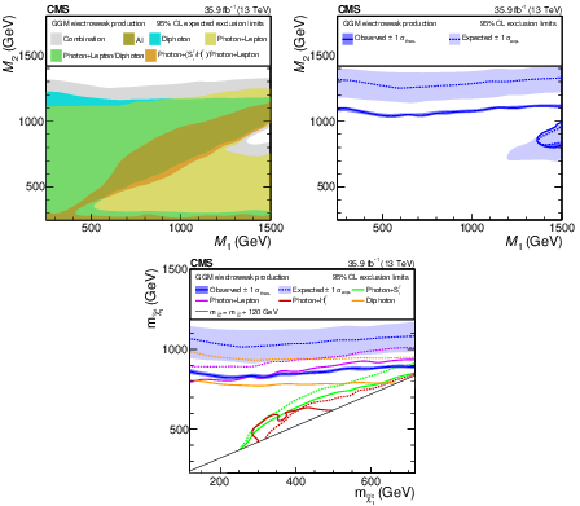
png pdf |
Figure 4:
The 95% CL exclusion limits for the GGM scenario in terms of the GGM model parameters (upper) and the physical neutralino and chargino masses (lower). The upper left panel shows the expected exclusion limits, where the area denoted as "all'' is excluded by all four individual categories. The upper right panel shows both the corresponding observed (full lines) and expected (dotted lines) exclusion limits for the combination in terms of the GGM model parameters. The lower panel shows the observed and the expected exclusion limits for the physical mass plane, where the phase space between the colored lines and the black line is excluded. In the physical mass plane only signal points with a mass difference above 120 GeV are shown to enable a precise projection of the physical masses from the GGM model parameters. The band around the expected limit of the combination indicates the region containing 68% of the distribution of limits expected under the background-only hypothesis. The band around the observed limit of the combination shows the spread in the observed limit from variation of the signal cross sections within their theoretical uncertainties. |
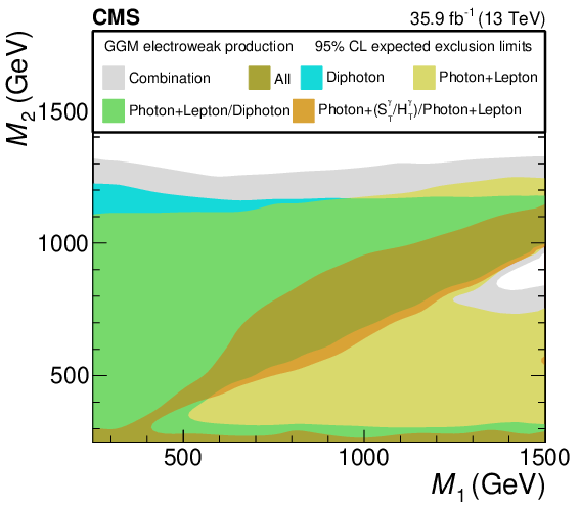
png pdf root |
Figure 4-a:
The 95% CL exclusion limits for the GGM scenario in terms of the GGM model parameters. The panel shows the expected exclusion limits, where the area denoted as "all'' is excluded by all four individual categories. |

png pdf root |
Figure 4-b:
The 95% CL exclusion limits for the GGM scenario in terms of the GGM model parameters. The panel shows both the corresponding observed (full lines) and expected (dotted lines) exclusion limits for the combination in terms of the GGM model parameters.The band around the expected limit of the combination indicates the region containing 68% of the distribution of limits expected under the background-only hypothesis. The band around the observed limit of the combination shows the spread in the observed limit from variation of the signal cross sections within their theoretical uncertainties. |

png pdf |
Figure 4-c:
The 95% CL exclusion limits for the GGM scenario in terms of the physical neutralino and chargino masses. The panel shows the observed and the expected exclusion limits for the physical mass plane, where the phase space between the colored lines and the black line is excluded. Only signal points with a mass difference above 120 GeV are shown to enable a precise projection of the physical masses from the GGM model parameters. The band around the expected limit of the combination indicates the region containing 68% of the distribution of limits expected under the background-only hypothesis. The band around the observed limit of the combination shows the spread in the observed limit from variation of the signal cross sections within their theoretical uncertainties. |

png pdf |
Figure 5:
The combined 95% CL NLSP mass exclusion limits for EW SMS production above 300 GeV. For the neutralino branching fraction scenario (left), the limit is shown as a function of the branching fraction $\tilde{\chi}^0_1 \to \gamma + \tilde{\mathrm{G}} $, the other decay channel being $\tilde{\chi}^0_1 \to \mathrm{Z} + \tilde{\mathrm{G}} $. For the chargino branching fraction scenario (right), the limit is shown as a function of the branching fraction $ {\tilde{\chi} _1^{\pm}}\to \tilde{\chi}^0_1 (\gamma \tilde{\mathrm{G}}) + \text {soft}$, the other decay channel being $ {\tilde{\chi} _1^{\pm}}\to \mathrm{W} + \tilde{\mathrm{G}} $. The full lines represent the observed and the dashed lines the expected exclusion limits, where the phase space below the lines is excluded. The band around the expected limit of the combination indicates the region containing 68% of the distribution of limits expected under the background-only hypothesis. The band around the observed limit of the combination shows the spread in the observed limit from variation of the signal cross sections within their theoretical uncertainties. |
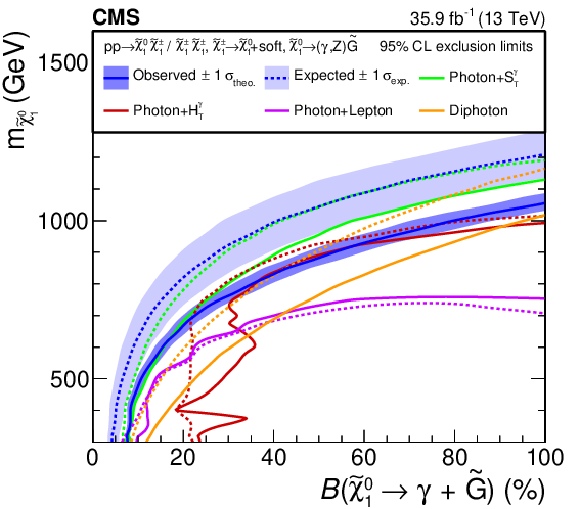
png pdf root |
Figure 5-a:
The combined 95% CL NLSP mass exclusion limits for EW SMS production above 300 GeV in the neutralino branching fraction scenario. The limit is shown as a function of the branching fraction $\tilde{\chi}^0_1 \to \gamma + \tilde{\mathrm{G}} $, the other decay channel being $\tilde{\chi}^0_1 \to \mathrm{Z} + \tilde{\mathrm{G}} $. The full lines represent the observed and the dashed lines the expected exclusion limits, where the phase space below the lines is excluded. The band around the expected limit of the combination indicates the region containing 68% of the distribution of limits expected under the background-only hypothesis. The band around the observed limit of the combination shows the spread in the observed limit from variation of the signal cross sections within their theoretical uncertainties. |

png pdf root |
Figure 5-b:
The combined 95% CL NLSP mass exclusion limits for EW SMS production above 300 GeV in the chargino branching fraction scenario. The limit is shown as a function of the branching fraction $ {\tilde{\chi} _1^{\pm}}\to \tilde{\chi}^0_1 (\gamma \tilde{\mathrm{G}}) + \text {soft}$, the other decay channel being $ {\tilde{\chi} _1^{\pm}}\to \mathrm{W} + \tilde{\mathrm{G}} $. The full lines represent the observed and the dashed lines the expected exclusion limits, where the phase space below the lines is excluded. The band around the expected limit of the combination indicates the region containing 68% of the distribution of limits expected under the background-only hypothesis. The band around the observed limit of the combination shows the spread in the observed limit from variation of the signal cross sections within their theoretical uncertainties. |

png pdf |
Figure 6:
The 95% CL exclusion limits for the nominal gluino scenario (left) assuming equal probabilities of 50% for the gluino decay to $\mathrm{q} \mathrm{\bar{q}} {\tilde{\chi} _1^{\pm}}$ and $\mathrm{q} \mathrm{\bar{q}} \tilde{\chi}^0_1 $. For the gluino branching fraction scenario (right) the ratio of the probabilities for both decays are scanned and the gluino mass is fixed to 1950 GeV. The Photon+Lepton category shows no exclusion power for the latter scenario. The full lines represent the observed and the dashed lines the expected exclusion limits, where the phase space below the lines is excluded. The band around the expected limit of the combination indicates the region containing 68% of the distribution of limits expected under the background-only hypothesis. The band around the observed limit of the combination shows the spread in the observed limit from variation of the signal cross sections within their theoretical uncertainties. |
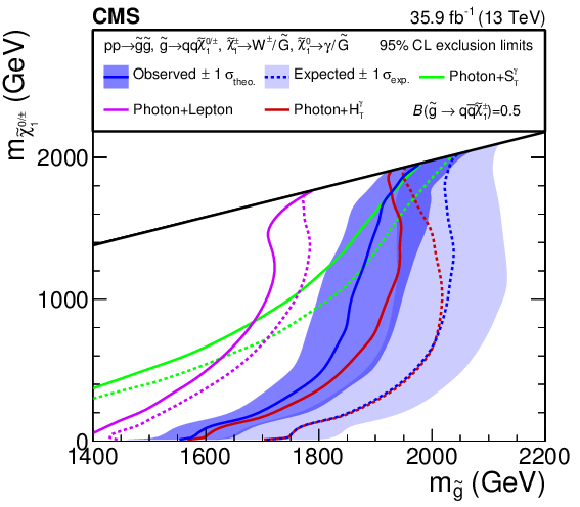
png pdf root |
Figure 6-a:
The 95% CL exclusion limits for the nominal gluino scenario assuming equal probabilities of 50% for the gluino decay to $\mathrm{q} \mathrm{\bar{q}} {\tilde{\chi} _1^{\pm}}$ and $\mathrm{q} \mathrm{\bar{q}} \tilde{\chi}^0_1 $. The full lines represent the observed and the dashed lines the expected exclusion limits, where the phase space below the lines is excluded. The band around the expected limit of the combination indicates the region containing 68% of the distribution of limits expected under the background-only hypothesis. The band around the observed limit of the combination shows the spread in the observed limit from variation of the signal cross sections within their theoretical uncertainties. |

png pdf root |
Figure 6-b:
The 95% CL exclusion limits for the gluino branching fraction scenario where the ratio of the probabilities for both decays are scanned and the gluino mass is fixed to 1950 GeV. The Photon+Lepton category shows no exclusion power for the latter scenario. The full lines represent the observed and the dashed lines the expected exclusion limits, where the phase space below the lines is excluded. The band around the expected limit of the combination indicates the region containing 68% of the distribution of limits expected under the background-only hypothesis. The band around the observed limit of the combination shows the spread in the observed limit from variation of the signal cross sections within their theoretical uncertainties. |
| Tables | |

png pdf |
Table 1:
Definitions of the four exclusive categories. The kinematic selections and the search bins are based on the four individual searches, while the additional vetoes shown in the third columns ensure exclusive event categories. The transverse mass of a photon/lepton and ${{p_{\mathrm {T}}} ^\text {miss}}$ is denoted as $ {m_{\mathrm {T}}} \left (\gamma /\ell, {{p_{\mathrm {T}}} ^\text {miss}} \right)$. The search bins always include the lower bounds. The Diphoton and Lepton veto match the kinematic selections of the Diphoton and Photon+Lepton category, respectively. The Diphoton veto is only used in the interpretation of the EW produced scenarios, but dropped for the strong produced scenarios, where the Diphoton category is not part of the combination. |
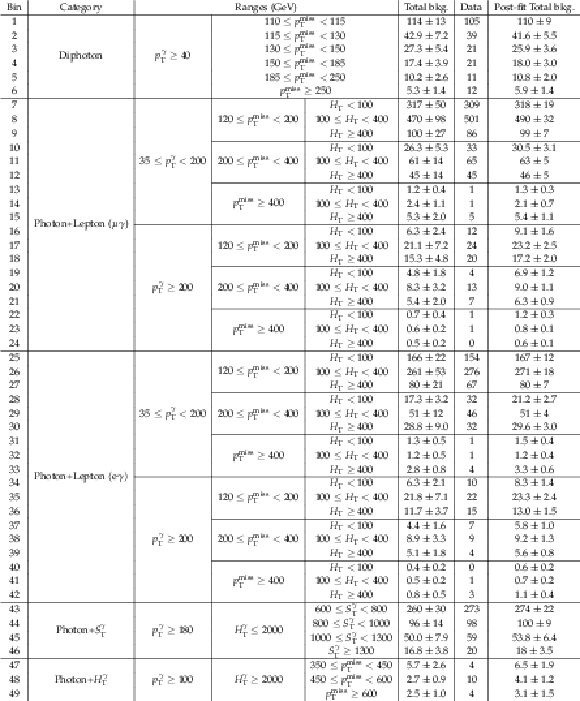
png pdf |
Table 2:
Predicted pre-fit background yields, where the values are not constrained by the likelihood fit, the observed number of events in data, and the post-fit background yields after the constraint from the likelihood fit for all search bins used in the combination. In addition the range covered by each individual bin is shown. |
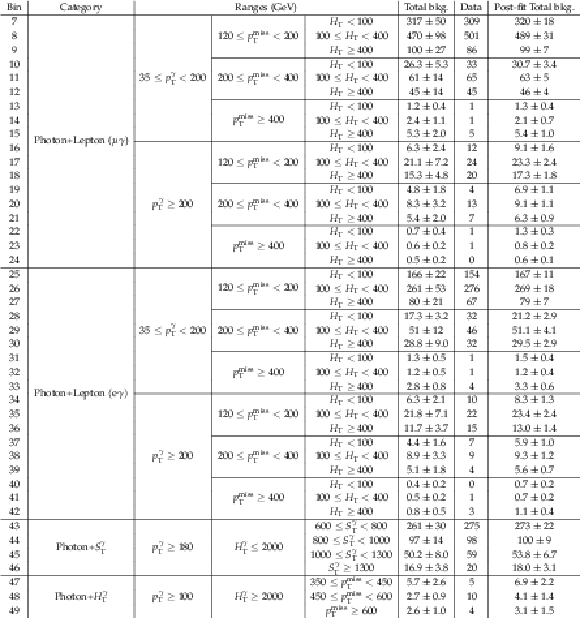
png pdf |
Table 3:
Predicted pre-fit background yields, where the values are not constrained by the likelihood fit, the observed number of events in data, and the post-fit background yields after the constraint from the likelihood fit for all search bins used in the combination. In addition the range covered by each individual bin is shown. For these yields, the Diphoton category is not included and the Diphoton veto is removed to increase the sensitivity of the Photon+$ {{H_{\mathrm {T}}} ^{\gamma}} $ category to strong production of gluinos. |
| Summary |
|
A combination of four different searches for general gauge-mediated (GGM) supersymmetry (SUSY) in final states with photons and a large transverse momentum imbalance was performed. Based on the event selection of the individual searches, four event categories were defined. Overlaps between the categories were removed by additional vetoes designed to maximize the sensitivity of the combination. Using data recorded with the CMS detector at the LHC at a center-of-mass energy of 13 TeV, and corresponding to an integrated luminosity of 35.9 fb$^{-1}$ , the combination improves the expected sensitivity of the searches described in Ref. [20,21,19,18]. The results are interpreted in the context of GGM SUSY and in simplified models. The sensitivity of the combination is also interpreted across a range of branching fractions, allowing for generalization to a wide range of SUSY scenarios. The results of the GGM scenario are expressed as limits on the physical mass parameters. Here, chargino masses up to 890 (1080) GeV are excluded by the observed (expected) limit across the tested neutralino mass spectrum, which ranges from 120 to 720 GeV. In electroweak production models, limits for neutralino masses are set up to 1050 (1200) GeV for combined $\tilde{\chi}_{1}^{\pm}\tilde{\chi}_{1}^{0}$ and $\tilde{\chi}_{1}^{\pm}\tilde{\chi}_{1}^{\mp}$ production, while for pure $\tilde{\chi}_{1}^{\pm}\tilde{\chi}_{1}^{\mp}$ production these limits are reduced to 825 (1000) GeV. For a strong production scenario based on gluino pair production, the highest excluded gluino mass is at 1975 (2050) GeV. The combination improves on the expected limits on neutralino and chargino masses by up to 100 GeV, while the expected limit on the gluino mass is increased by 50 GeV compared to the individual searches. |
| Additional Figures | |

png pdf root |
Additional Figure 1:
Combined observed exclusion for the GGM scenario in terms of the GGM model parameters. |

png pdf root |
Additional Figure 1-a:
Pre-fit background covariance matrix for the combination. The matrix shows the correlations between search regions of the combination and provides the necessary information for merging search regions for re-interpretation of the results. The first four bins are the Photon+$ {S^{\gamma}_{T}}$ bins and the next three ${{p_{\mathrm {T}}} ^\text {miss}}$ bins are at high Photon+$ {H^{\gamma}_{T}}$. This is followed by the thirty-six analysis search bins for muon-photon and electron-photon final states, and the last six bins are the ${{p_{\mathrm {T}}} ^\text {miss}}$ search bins of diphoton events. |
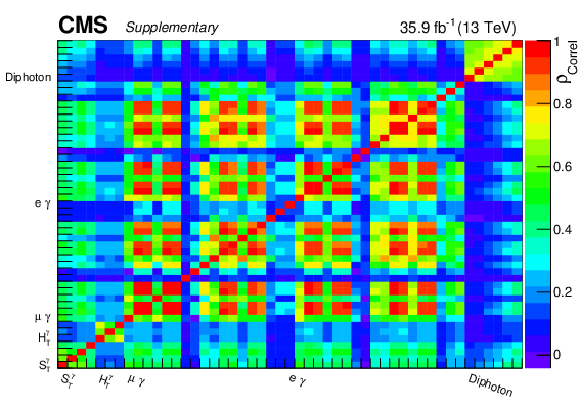
png pdf root |
Additional Figure 1-b:
Correlation matrix computed from the pre-fit covariance matrix. The matrix shows the correlations between search regions of the combination and provides the necessary information for merging search regions for re-interpretation of the results. The first four bins are the Photon+$ {S^{\gamma}_{T}}$ bins and the next three ${{p_{\mathrm {T}}} ^\text {miss}}$ bins are at high Photon+$ {H^{\gamma}_{T}}$. This is followed by the thirty-six analysis search bins for muon-photon and electron-photon final states, and the last six bins are the ${{p_{\mathrm {T}}} ^\text {miss}}$ search bins of diphoton events. |
| References | ||||
| 1 | M. Dine and W. Fischler | A phenomenological model of particle physics based on supersymmetry | PLB 110 (1982) 227 | |
| 2 | L. Alvarez-Gaume, M. Claudson, and M. B. Wise | Low-energy supersymmetry | NPB 207 (1982) 96 | |
| 3 | C. R. Nappi and B. A. Ovrut | Supersymmetric extension of the SU(3)xSU(2)xU(1) model | PLB 113 (1982) 175 | |
| 4 | M. Dine and A. E. Nelson | Dynamical supersymmetry breaking at low energies | PRD 48 (1993) 1277 | hep-ph/9303230 |
| 5 | M. Dine, A. E. Nelson, and Y. Shirman | Low energy dynamical supersymmetry breaking simplified | PRD 51 (1995) 1362 | hep-ph/9408384 |
| 6 | M. Dine, A. E. Nelson, Y. Nir, and Y. Shirman | New tools for low-energy dynamical supersymmetry breaking | PRD 53 (1996) 2658 | hep-ph/9507378 |
| 7 | G. R. Farrar and P. Fayet | Phenomenology of the production, decay, and detection of new hadronic states associated with supersymmetry | PLB 76 (1978) 575 | |
| 8 | S. Dimopoulos, G. F. Giudice, and A. Pomarol | Dark matter in theories of gauge mediated supersymmetry breaking | PLB 389 (1996) 37 | hep-ph/9607225 |
| 9 | S. P. Martin | Generalized messengers of supersymmetry breaking and the sparticle mass spectrum | PRD 55 (1997) 3177 | hep-ph/9608224 |
| 10 | E. Poppitz and S. P. Trivedi | Some remarks on gauge mediated supersymmetry breaking | PLB 401 (1997) 38 | hep-ph/9703246 |
| 11 | P. Meade, N. Seiberg, and D. Shih | General gauge mediation | Prog. Theor. Phys. Suppl. 177 (2009) 143 | 0801.3278 |
| 12 | M. Buican, P. Meade, N. Seiberg, and D. Shih | Exploring general gauge mediation | JHEP 03 (2009) 016 | 0812.3668 |
| 13 | S. Abel, M. J. Dolan, J. Jaeckel, and V. V. Khoze | Phenomenology of pure general gauge mediation | JHEP 12 (2009) 001 | 0910.2674 |
| 14 | L. M. Carpenter, M. Dine, G. Festuccia, and J. D. Mason | Implementing general gauge mediation | PRD 79 (2009) 035002 | 0805.2944 |
| 15 | T. T. Dumitrescu, Z. Komargodski, N. Seiberg, and D. Shih | General messenger gauge mediation | JHEP 05 (2010) 096 | 1003.2661 |
| 16 | ATLAS Collaboration | Search for supersymmetry in a final state containing two photons and missing transverse momentum in $ \sqrt{s} = $ 13 TeV pp collisions at the LHC using the ATLAS detector | EPJC 76 (2016) 517 | 1606.09150 |
| 17 | ATLAS Collaboration | Search for photonic signatures of gauge-mediated supersymmetry in 13 TeV pp collisions with the ATLAS detector | PRD 97 (2018) 092006 | 1802.03158 |
| 18 | CMS Collaboration | Search for supersymmetry in final states with photons and missing transverse momentum in proton-proton collisions at 13 TeV | JHEP 06 (2019) 143 | CMS-SUS-17-011 1903.07070 |
| 19 | CMS Collaboration | Search for supersymmetry in events with a photon, a lepton, and missing transverse momentum in proton-proton collisions at $ \sqrt{s} = $ 13 TeV | JHEP 01 (2019) 154 | CMS-SUS-17-012 1812.04066 |
| 20 | CMS Collaboration | Search for gauge-mediated supersymmetry in events with at least one photon and missing transverse momentum in pp collisions at $ \sqrt{s} = $ 13 TeV | PLB 780 (2018) 118 | CMS-SUS-16-046 1711.08008 |
| 21 | CMS Collaboration | Search for supersymmetry in events with at least one photon, missing transverse momentum, and large transverse event activity in proton-proton collisions at $ \sqrt{s}= $ 13 TeV | JHEP 12 (2017) 142 | CMS-SUS-16-047 1707.06193 |
| 22 | CMS Collaboration | Interpretation of searches for supersymmetry with simplified models | PRD 88 (2013) 052017 | CMS-SUS-11-016 1301.2175 |
| 23 | P. Grajek, A. Mariotti, and D. Redigolo | Phenomenology of general gauge mediation in light of a 125 GeV Higgs | JHEP 07 (2013) 109 | 1303.0870 |
| 24 | S. Knapen and D. Redigolo | Gauge mediation at the LHC: status and prospects | JHEP 01 (2017) 135 | 1606.07501 |
| 25 | S. Knapen, D. Redigolo, and D. Shih | General gauge mediation at the weak scale | JHEP 03 (2016) 046 | 1507.04364 |
| 26 | W. Beenakker, R. Hopker, and M. Spira | PROSPINO: A program for the production of supersymmetric particles in next-to-leading order QCD | hep-ph/9611232 | |
| 27 | J. Butterworth et al. | PDF4LHC recommendations for LHC run II | JPG 43 (2016) 023001 | 1510.03865 |
| 28 | A. Buckley et al. | LHAPDF6: parton density access in the LHC precision era | EPJC 75 (2015) 132 | 1412.7420 |
| 29 | NNPDF Collaboration | Parton distributions for the LHC run II | JHEP 04 (2015) 040 | 1410.8849 |
| 30 | T. Sjostrand, S. Mrenna, and P. Z. Skands | A brief introduction to PYTHIA 8.1 | CPC 178 (2008) 852 | 0710.3820 |
| 31 | CMS Collaboration | Event generator tunes obtained from underlying event and multiparton scattering measurements | EPJC 76 (2016) 155 | CMS-GEN-14-001 1512.00815 |
| 32 | J. Alwall et al. | The automated computation of tree-level and next-to-leading order differential cross sections, and their matching to parton shower simulations | JHEP 07 (2014) 079 | 1405.0301 |
| 33 | W. Beenakker et al. | Production of charginos, neutralinos, and sleptons at hadron colliders | PRL 83 (1999) 3780 | hep-ph/9906298 |
| 34 | B. Fuks, M. Klasen, D. R. Lamprea, and M. Rothering | Gaugino production in proton-proton collisions at a center-of-mass energy of 8 TeV | JHEP 10 (2012) 081 | 1207.2159 |
| 35 | B. Fuks, M. Klasen, D. R. Lamprea, and M. Rothering | Precision predictions for electroweak superpartner production at hadron colliders with Resummino | EPJC 73 (2013) 2480 | 1304.0790 |
| 36 | W. Beenakker, R. Hopker, M. Spira, and P. M. Zerwas | Squark and gluino production at hadron colliders | NPB 492 (1997) 51 | hep-ph/9610490 |
| 37 | A. Kulesza and L. Motyka | Threshold resummation for squark-antisquark and gluino-pair production at the LHC | PRL 102 (2009) 111802 | 0807.2405 |
| 38 | A. Kulesza and L. Motyka | Soft gluon resummation for the production of gluino-gluino and squark-antisquark pairs at the LHC | PRD 80 (2009) 095004 | 0905.4749 |
| 39 | W. Beenakker et al. | Soft-gluon resummation for squark and gluino hadroproduction | JHEP 12 (2009) 041 | 0909.4418 |
| 40 | W. Beenakker et al. | Squark and gluino hadroproduction | Int. J. Mod. Phys. A 26 (2011) 2637 | 1105.1110 |
| 41 | C. Borschensky et al. | Squark and gluino production cross sections in pp collisions at $ \sqrt{s} = $ 13, 14, 33 and 100 TeV | EPJC 74 (2014) 3174 | 1407.5066 |
| 42 | S. Abdullin et al. | The fast simulation of the CMS detector at LHC | J. Phys.: Conf. Ser. 331 (2011) 032049 | |
| 43 | GEANT4 Collaboration | GEANT4---a simulation toolkit | NIMA 506 (2003) 250 | |
| 44 | CMS Collaboration | Performance of photon reconstruction and identification with the CMS detector in proton-proton collisions at $ \sqrt{s} = $ 8 TeV | JINST 10 (2015) P08010 | CMS-EGM-14-001 1502.02702 |
| 45 | CMS Collaboration | The CMS experiment at the CERN LHC | JINST 3 (2008) S08004 | CMS-00-001 |
| 46 | CMS Collaboration | Particle-flow reconstruction and global event description with the CMS detector | JINST 12 (2017) P10003 | CMS-PRF-14-001 1706.04965 |
| 47 | M. Cacciari, G. P. Salam, and G. Soyez | The anti-$ {k_{\mathrm{T}}} $ jet clustering algorithm | JHEP 04 (2008) 063 | 0802.1189 |
| 48 | CMS Collaboration | Performance of missing transverse momentum in pp collisions at $ \sqrt{s}= $ 13 TeV using the CMS detector | CMS-PAS-JME-17-001 | CMS-PAS-JME-17-001 |
| 49 | K. Rehermann and B. Tweedie | Efficient identification of boosted semileptonic top quarks at the LHC | JHEP 03 (2011) 059 | 1007.2221 |
| 50 | M. Cacciari and G. P. Salam | Pileup subtraction using jet areas | PLB 659 (2008) 119 | 0707.1378 |
| 51 | T. Junk | Confidence level computation for combining searches with small statistics | NIMA 434 (1999) 435 | hep-ex/9902006 |
| 52 | A. L. Read | Presentation of search results: the CLs technique | JPG 28 (2002) 2693 | |
| 53 | ATLAS and CMS Collaborations, and LHC Higgs Combination Group | Procedure for the LHC Higgs boson search combination in summer 2011 | CMS-NOTE-2011-005 | |
| 54 | G. Cowan, K. Cranmer, E. Gross, and O. Vitells | Asymptotic formulae for likelihood-based tests of new physics | EPJC 71 (2011) 1554 | 1007.1727 |

|
Compact Muon Solenoid LHC, CERN |

|

|

|

|

|

|